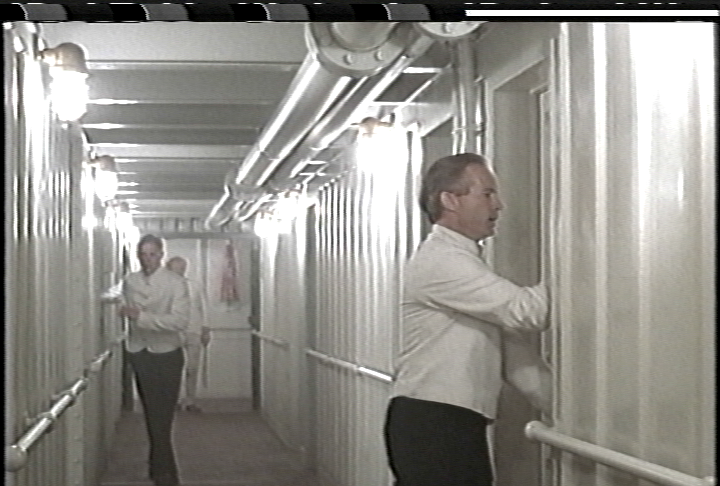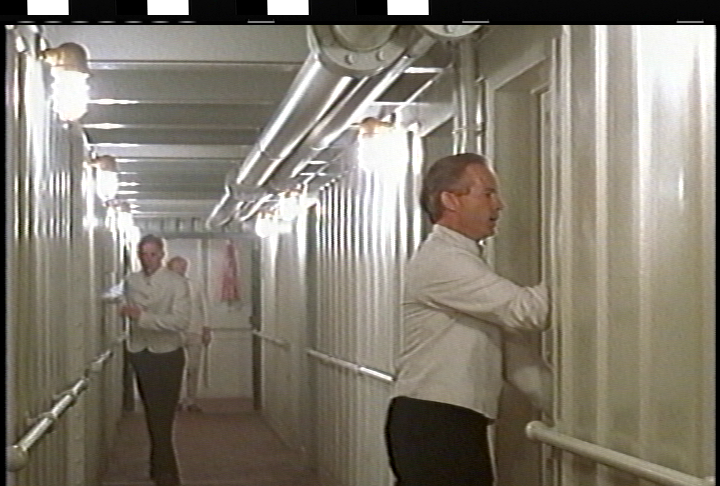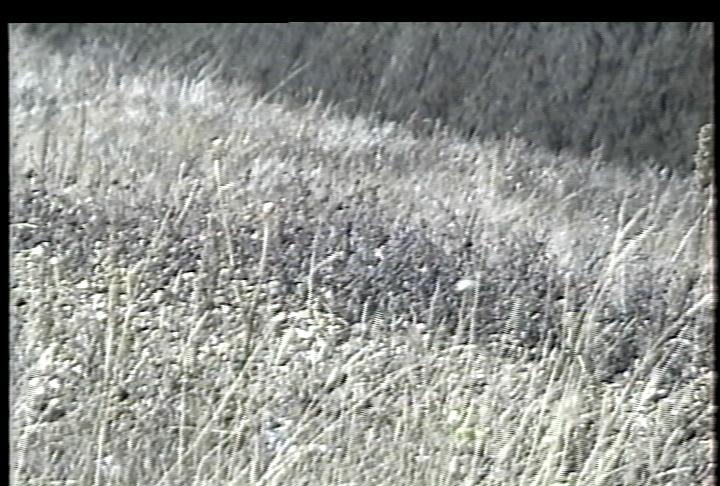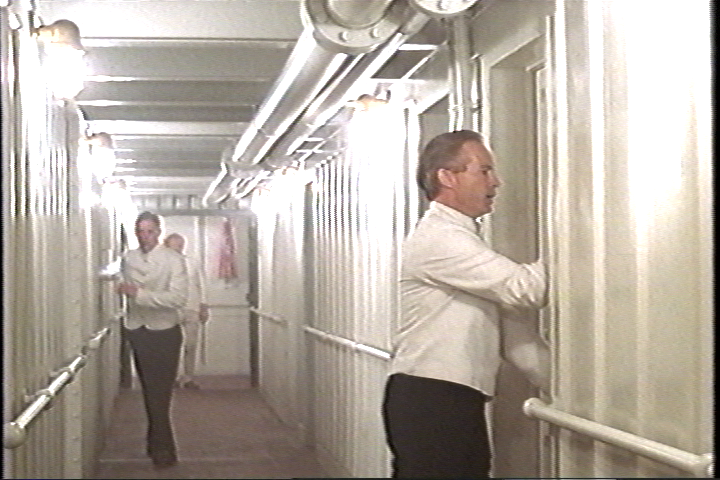First a blow-up of a capture with the NTSC line numbers identified. Because they are numbered sequentially by field, they alternate when viewed as a full raster.
The second field begins with line 264, so if you subtract 263 from its line numbers you get the number relative to its start (i.e. line 284 is line 21 of the second field). The first 9 lines of each field contain "equalization pulses and broad pulses" rather than vertical interval video.
.........VCR -> DPS..........VCR -> DMR-ES15 -> DPS...VCR -> D-KR4 -> DPS..




I thought it was interesting to "see" what Macrovision looks like (though the ColorStripe version also occupies the horizontal sync area). Apparently you can take a look at this using the vertical hold controls on older CRTs as well, and one guy on YouTube found an LCD that allows a wide vertical adjustment range.
You can see what the two DVD recorders do when passing signals through to the outputs:
The chat line commercial is from a 2003 recording. The station likely used a digital source with only 480 active lines. The image begins at line 23 (adhering to SMPTE RP 202).
- black out everything before line 23
- re-add closed captions from the source, if present
- generate a new Macrovision signal if one was detected
The VHS camcorder that my family used in the '90s doesn't have anything in the VBI. The image starts with the half-line on line 284 followed by the first full line on line 22. Since line 21 was reserved in 1976, other analog camcorders probably do the same thing.

The Diamond VC500 USB stick starts capturing at line 22. Unlike the DVD recorders' passthrough, the DPS-470AV frame sync's composite output leaves lines 22 and 285 intact. It smooths the picture, though. (The second image is overblown because of the VC500's reaction to Macrovision.)
..VCR -> DPS -> VC500..........VCR -> VC500........


Try StreamFab Downloader and download from Netflix, Amazon, Youtube! Or Try DVDFab and copy Blu-rays! or rip iTunes movies!
+ Reply to Thread
Results 1 to 12 of 12
Thread
-
-
Interesting stuff.
You could try a broadcast monitor. Put it into "Pulse Cross", or "H and V Delay" mode.
See here...
http://www.davidstringer.info/training/how_television_works.htm
...search the page for pulse cross to find a picture of what you'll get.
These things used to cost a fortune, but now the SD-only versions sometimes turn up for peanuts.
Cheers,
David.
-
-
For what purpose?
Old capture cards with a specific chip can use special Linux drivers to write raw ADC data. This is all terminal stuff, and currently the data can't be decoded to a stable color image. Perhaps you're interested in enhancing the software?
-
Some of the Osprey cards can show the VBI as a waveform.
-
Here's one I haven't seen before. A data code overlaid on top of Macrovision. These data lines aren't uncommon, but this time the MV signal is partially obscured.
My YouTube channel with little clips: vhs-decode, comparing TBC, etc. -
Number of active lines in NTSC sources. From what I've seen, 482 (+ 1 half, at bottom) is common. Sometimes there are more.
484 (+ 2 half). Unknown Hi8 camcorder, almost-definitely Sony, and from the date stamp we can see it was sold 1995 or before.
Blackmagic Intensity Pro 4K capture (no TBC).
The rest of the images are via vhs-decode. Dimensions of the luma-only images are 910x525.
482 (+ 2 half + 1 CC + 1 data/half). This one is slightly complex. Cropping the blanking and VITS, we start with 486. Subtract the top and bottom half-lines. We're left with Line 21 Closed Captions on top. Subtract that line, and the next line still has a data-code "run-in" before the active video.
483 (+ 1 half + 1 CC). Cropping the top to the captions brings us down to 485. Subtract the bottom half-line. Subtract the caption line, and we start with a full line straight away this time.
482 (+ 1 half + 1 CC). Later in the episode, same camera angle, one fewer intact line! That line immediately below the CCs is actually blanked for most of the episode.
484 (+2 half). No CCs here, so like the Hi8 tape we've basically hit the limit of active NTSC lines.
vhs-decode full-color images; 760x485. (By default, vhs-decode crops down for final output and pads to 488. I've removed the padding.)
The top shot here crossfades into the one below. If we're not counting the half-line as "intact" then the camera shot has 2 extra lines compared to the computer graphic.
For my friend dellsam34.
Last edited by Brad; 15th May 2022 at 09:01.
My YouTube channel with little clips: vhs-decode, comparing TBC, etc. -
That's cool. Where did you get a device that let you capture all of the blanking and sync areas of the signal? I've been looking for something that could do that, digitizing the raw composite video signal. Can you tell me the model of your capture card? Was this a professional video capture device designed to capture absolutely everything in an analog video signal, with the intent of it being used for professional signal analysis to monitor the quality of absolutely every part of the video signal (not just the active picture area)? If so, how much did it cost? It sounds like a piece of equipment that would cost thousands of dollars.
-
Hey Brad, in your previous VHSdecode screenshots I don't see the head switch noise, it should be part of the 486 lines. In the cartoon shot head switch noise is included that's why it came up to 485.
This is an ongoing project called VHS-decode, frames are 910x525, read the first posts of that thread to understand what this project is and what are its objectives.Last edited by dellsam34; 15th May 2022 at 17:17.
-
For those captures, I moved the head-switching point into the VBI. If you look at the VSync in the B&W shots, it should hopefully be clear that it's distorted. That's where the head switch is.
https://forum.videohelp.com/threads/394168-Current-status-of-ld-decode-vhs-decode-(tru...30#post2654472
https://forum.videohelp.com/threads/395625-How-to-capture-with-no-head-switching-noise...ertain-VCRs%29My YouTube channel with little clips: vhs-decode, comparing TBC, etc. -
-
See the vhs-decode thread in the capturing section, you can't miss it.
Similar Threads
-
[SOLVED] Horizontal scan lines & jagged edges - FCPX
By crjackson in forum MacReplies: 5Last Post: 5th Jun 2013, 15:11 -
Restoring VHS (Tracking and Scan Lines) Random Pulses
By Deter in forum RestorationReplies: 44Last Post: 27th Feb 2012, 00:09 -
Reducing/eliminating scan lines?
By Captain Satellite in forum Video ConversionReplies: 9Last Post: 23rd Nov 2011, 06:37 -
Scan lines in the rip.....any help would be good
By Spinal_Core in forum DVD RippingReplies: 11Last Post: 27th Aug 2011, 12:57 -
Video Scan Lines
By sunnah in forum Newbie / General discussionsReplies: 7Last Post: 10th May 2011, 20:05



 Quote
Quote
